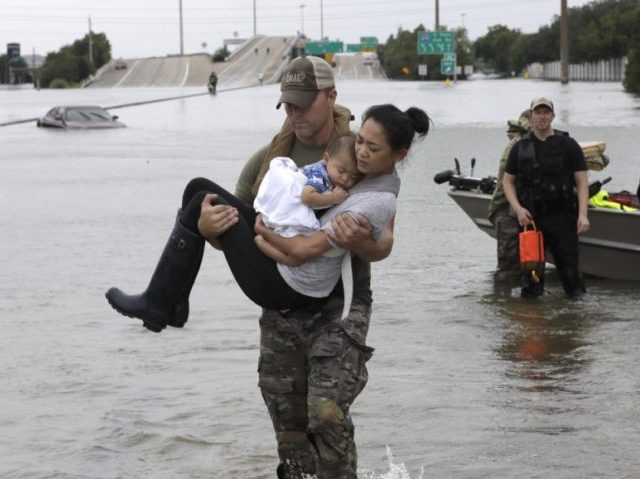The unfolding disaster in Texas has led some to speculate that the Fed may need to hold interest rates lower for even longer to aid with the recovery. That may be a misreading of how the disaster of Hurricane Harvey will affect the Fed’s decisions.
If it has any effect, Harvey may result in the Fed tightening its monetary stance by raising rates more quickly.
There is not much research on how monetary policy officials react to natural disasters. Nonetheless, both the general public and many Fed watchers appear to believe that natural disasters such as damaging hurricanes are dovish events. The assumption is that the Federal Reserve will attempt to ease monetary policy to offset the fall in economic output caused by the disaster.
On Monday, as reports from flooded Houston and surrounding areas flashed across American screens, the Fed Funds futures market seemed to confirm these expectations. The very small odds that the market was giving to the idea of a rate hike in November fell to 4 percent from 6 percent the previous Friday. Futures contracts for the next six Fed meetings showed growing odds of the Fed sitting pat and shrinking odds of a hike. In fact, for the first time the Fed Funds futures market now gives just about even odds of no hike (44 percent) and one hike (42 percent) by August of 2018.
For a few hours on Monday, the Fed Funds futures market appeared to even be pricing in a tiny chance that the Fed could cut its target rate in November.
This dovishness may be unwarranted. When Benjamin Keen of the University of Oklahoma and Michael Pakko of the University of Arkansas at Little Rock investigated the appropriate monetary policy response to natural disasters, they found that the optimal policy would involve raising interest rates. This conclusion held even when Keen and Pakko looked at possible responses under alternative economic models using different assumptions.
The public tends to concentrate on the losses and suffering caused by a natural disasters. Economic productivity falls as the disruptive disaster closes businesses and forces workers to relocate. Disasters can also destroy machinery, computers, roads, and buildings, taking a heavy toll on what economists call the “capital stock” of an area. The process of recovery and rebuilding, including an influx of aid dollars from both public and private sources, creates its own economic pressures. Employment tends to rise, as does investment and inflation.
Why inflation? Keep in mind that disasters are just that: disastrous. They deplete resources, destroy property, damage communities without adding anything. It’s not creative destruction. It is destructive destruction. Replenishing a community’s economic resources creates more demand for things like building materials and workers. Households have to replace appliances, furniture, and other lost property. There are, for example, a lot of cars that have probably been effectively useless by the flood waters. All that added demand is an inflationary pressure on the economy.
It is the inflationary aspect of disaster recovery that may tip the Fed toward a more hawkish stance. For a Fed that has been frustrated at its failure to produce inflation at its target rate of two percent, the recovery inflation may even be something of a gift. It could be seen as allowing the Fed to once again resume the “normalization” of interest rates, instead of the slow-crawl the market now predicts.
The market has scored disasters wrong before. In 2005, many Fed watchers thought that the devastation caused by Hurricane Katrina would result in the Fed deciding not to raise rates at its September 20 meeting.
“Before the hurricane…economists considered it a foregone conclusion that Fed policy makers would boost short-term rates by another quarter percentage point….Now, a growing number of economists say the odds are rising that the Fed might take a pass,” a September 7, 2005, Cincinnati Post article explained.
Fed funds futures showed the odds of rate hikes in September or October were falling.
At its September 20 meeting, however, the Fed policymakers raised the federal funds rate by a quarter of a point–exactly as the market had expected before Katrina. “While these unfortunate developments have increased uncertainty about near-term economic performance, it is the Committee’s view they do not pose a more persistent threat,” the Fed said in its statement.

COMMENTS
Please let us know if you're having issues with commenting.